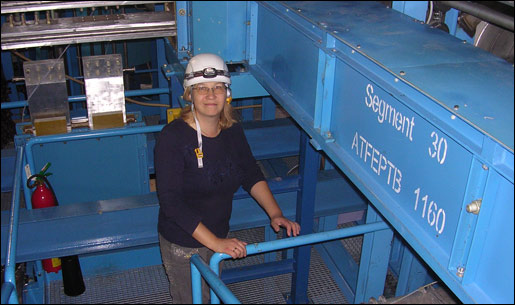
ATLAS e-News
23 February 2011
25 February 2008
Tatiana Klioutchnikova
Nationality: Russian
 Tatiana Klioutchnikova
Tatiana Klioutchnikova
We’ve all heard the story about the End Cap Toroid magnets having only a few centimetres clearance on either side as they were eased into place in the detector last year. Well, Tatiana Klioutchnikova and her colleagues are the ones to thank for that carefully controlled close-shave not ending up in a disastrous scrape.
Tatiana, a mechanical engineer, works with Computer Aided Design (CAD) and 3D models of the detector to ensure that every last piece, cable, strut, and cryogenic pipe is accounted for; she knows the details and dimensions of every component of the detector, and, more importantly, how they’ll fit together. If ATLAS is the world’s biggest jigsaw puzzle, then Tatiana is the artist illustrating the box.
She moved to Switzerland 13 years ago, from Russia: “I worked in an institute in Russia, also in high energy physics,” she remembers. “The research centre was building an accelerator similar to the LHC, but the situation changed in the country and there was no money available to finish the project, so many physicists came to work here.”
When she arrived in 1995, her first task was to sort through a mass of simple sketches submitted by ATLAS physicists, which proposed a layout for the detector. At this stage, each component was represented by rudimentary “blocks” or “envelopes”, intended just to reserve space.
By contacting the institutions all over the world where each of the various components were being designed, Tatiana and the team were able to amass more details about the size and shape of each piece. From this, they began to bring together the thousands of drawings they had, and reproduce them in 3D. As this information built up over time, they fed accumulated data from their multiple models into the CAD system. Catia, the system they use today, is identical to those used to design aircraft and cars, and displays fine details such as cables and pipes.
Alongside all this attention to detail, Tatiana’s role demands a certain amount of flexibility. Initially, some of the designers were unsure of how many electronic boxes and cables they would be fitting, and the team had to make a rough estimation of how much space to leave for them between the detectors. When this turned out not to be too tight a squeeze, elements of the detector design had to be re-positioned slightly to accommodate the new measurements.
This challenge/response way of working reflects Tatiana’s sentiments about the differences between working in Russia and Switzerland: “CERN is a completely free and democratic organisation, and people are working here with pleasure. At home it was more formal; your boss tells you what you must do. Here, you decide for yourself what is needed.”
Working environment aside, she is clear that one of the biggest perks of working in Switzerland is the moderate climate and comparatively long summer. Originally from the far east of Russia, she spent several years in Siberia as a teenager, where temperatures were as low as -40ºC.
“It’s completely different from Russia! It surprised me greatly. I could not imagine such a nice country. Right now it’s winter – you can see snow, but you can still see green and trees,” she smiles. “In Russia, everything is black and white in winter, for many months.”
In fact, since coming to Europe, Tatiana has become a real sun-seeker. Once she and her husband had visited all the local museums and galleries, they set their sites further afield, and have now travelled most of Europe together. Not at all bad for someone who didn’t leave their home country before the age of 35!
